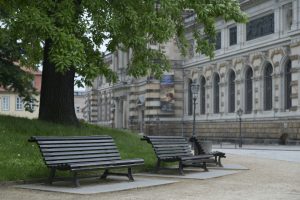Does urban nature make us healthy and happy? – A short report from the STUPS project: Urban nature supports psychological well-being
The Anchoring Effect Using Dresden's Urban Nature as an Example
If you want to observe a psychological phenomenon in real life, we recommend a small experiment on the anchoring effect. All you have to do is ask a small group of people a question: How many allotment garden associations are there in Dresden? One person in the group makes the first estimate (e.g. 35 associations) and influences all the answers that come after it. They will probably be between 20 and 150, but will not stray too far from the number given at the beginning, which is the only "anchor" unless you have better clues. So, what do you think? How many allotment associations are there in the area of state capital Dresden? After all, Dresden is one of the greenest cities in Germany. In fact, there are three hundred and sixty-nine clubs. Together they cover an area of over 792 hectares (in more popular units of area, that is about 1110 football pitches or 0.3 % of the Saarland). The »Naturheilverein Dresden-Löbtau and Surrounding Area« eV is one of the oldest allotment garden associations in Dresden. And it is precisely this time-honored theme of how urban nature can serve health and healing that is at the heart of the STUPS project (STadtnatur Usupported Psychical well-being), which runs from May 2020 to spring 2021 at media center running.
The STUPS project

The STUPS project is about what nature does to our minds in cities. Does it keep us healthy, does it help us concentrate better or does it help us recover faster? Does the wind blow away the gloomy old thoughts and free us up for new ones?
We are currently investigating these questions (although somewhat less poetically) at the Media Center of the TU DresdenWe look at publications from the past ten years that relate (internationally) to urban greenery and mental health and summarize the new information from these publications in terms of content and numbers. The idea behind such a summary (review or meta-analysis) is that several studies together produce a more reliable statement than individual ones.
In our understanding, mental health is more than just the absence of mental illness, but also includes mental performance and personal well-being. And we also want to treat urban greenery in a much broader sense than just looking at allotments: urban nature is omnipresent, but varies greatly in quality and quantity and therefore presumably also in its health effects. Our focus is on parks, meadows and forests in cities and on the outskirts of cities, but also on urban houseplants, images of nature or natural scenarios in virtual reality. The latter media representations of nature also explain the location at the media center. A possible follow-up project could compare the effects of virtual and "real" nature.
Initial results indicate an immense range of positive effects of nature, from better concentration and relaxation to faster healing when looking out the window into greenery and increased social interaction in natural spaces. It is also interesting, however, that such study results are often subject to a distortion, particularly in western countries, which unanimously portray nature as positive. In tropical regions, the view of nature also includes its dangers, e.g. from natural disasters, snakes and disease transmission by mosquitoes. In Germany, the risks posed by urban nature are rather limited. Based on initial findings, spending time in green spaces is therefore highly recommended - more results to follow.
contact
Woman Marilisa Herchet
Tel.: +49 351 463-40145
Mail: marilisa.herchet@tu-dresden.de







